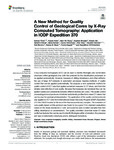A New Method for Quality Control of Geological Cores by X-Ray Computed Tomography: Application in IODP Expedition 370
| dc.contributor.author | Tonai, S | |
| dc.contributor.author | Kubo, Y | |
| dc.contributor.author | Tsang, M-Y | |
| dc.contributor.author | Bowden, S | |
| dc.contributor.author | Ide, K | |
| dc.contributor.author | Hirose, T | |
| dc.contributor.author | Kamiya, N | |
| dc.contributor.author | Yamamoto, Y | |
| dc.contributor.author | Yang, K | |
| dc.contributor.author | Yamada, Y | |
| dc.contributor.author | Morono, Y | |
| dc.contributor.author | Heuer, VB | |
| dc.contributor.author | Inagaki, F | |
| dc.date.accessioned | 2019-06-28T14:13:15Z | |
| dc.date.available | 2019-06-28T14:13:15Z | |
| dc.date.issued | 2019-05-31 | |
| dc.identifier.issn | 2296-6463 | |
| dc.identifier.issn | 2296-6463 | |
| dc.identifier.uri | http://hdl.handle.net/10026.1/14486 | |
| dc.description.abstract |
X-ray computed tomography (XCT) can be used to identify lithologies and deformation structures within geological core, with the potential for the identification processes to be applied automatically. However, because of drilling disturbance and other artifacts, the use of large XCT-datasets in automated processes requires methods of quality control that can be applied systematically. We propose a new systematic method for quality control of XCT data that applies numerical measures to CT slices, and from this obtains data reflective of core quality. Because the measures are numerical they can be applied quickly and consistently between different sections and cores. This quality control processing protocol produces downhole radiodensity profiles from mean CT-values that can be used for geological interpretation. The application of this quality control protocols was applied to XCT data from International Ocean Discovery Program (IODP) Expedition 370 Site C0023 located at the toe of the Nankai accretionary complex. The evaluation of core quality based on this protocol was found to be a good fit to standard-evaluations based on the visual description of core, and could be used to select samples free from drilling disturbance or contamination. The quality-controlled downhole mean CT-value profile has features that can be used to identify lithologies within a formation, the presence and type of deformation structures and to distinguish formations. | |
| dc.format.extent | 117- | |
| dc.language.iso | en | |
| dc.publisher | Frontiers Media | |
| dc.title | A New Method for Quality Control of Geological Cores by X-Ray Computed Tomography: Application in IODP Expedition 370 | |
| dc.type | journal-article | |
| plymouth.volume | 7 | |
| plymouth.publication-status | Published online | |
| plymouth.journal | Frontiers in Earth Science | |
| dc.identifier.doi | 10.3389/feart.2019.00117 | |
| plymouth.organisational-group | /Plymouth | |
| plymouth.organisational-group | /Plymouth/Faculty of Science and Engineering | |
| plymouth.organisational-group | /Plymouth/Faculty of Science and Engineering/School of Geography, Earth and Environmental Sciences | |
| plymouth.organisational-group | /Plymouth/REF 2021 Researchers by UoA | |
| plymouth.organisational-group | /Plymouth/REF 2021 Researchers by UoA/UoA07 Earth Systems and Environmental Sciences | |
| plymouth.organisational-group | /Plymouth/Users by role | |
| plymouth.organisational-group | /Plymouth/Users by role/Academics | |
| dcterms.dateAccepted | 2019-05-06 | |
| dc.rights.embargodate | 2019-7-5 | |
| dc.identifier.eissn | 2296-6463 | |
| dc.rights.embargoperiod | Not known | |
| rioxxterms.versionofrecord | 10.3389/feart.2019.00117 | |
| rioxxterms.licenseref.uri | http://www.rioxx.net/licenses/all-rights-reserved | |
| rioxxterms.licenseref.startdate | 2019-05-31 | |
| rioxxterms.type | Journal Article/Review |


